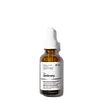What's inside
What's inside
 Key Ingredients
Key Ingredients

 Benefits
Benefits

 Concerns
Concerns

No concerns
 Ingredients Side-by-side
Ingredients Side-by-side

Water
Skin ConditioningPropanediol
SolventAscorbyl Glucoside
AntioxidantErgothioneine
AntioxidantEpigallocatechin Gallatyl Glucoside
AntioxidantAcetyl Tetrapeptide-2
Skin ConditioningHeptapeptide-6
Skin ConditioningTocotrienols
Skin ConditioningTremella Fuciformis Sporocarp Extract
AntioxidantSphingomonas Ferment Extract
Skin ConditioningPanax Ginseng Root Extract
EmollientBixa Orellana Seed Extract
MaskingGlycerin
HumectantIsoceteth-20
EmulsifyingCitric Acid
BufferingSodium Citrate
BufferingSodium Hydroxide
BufferingCaprylyl Glycol
EmollientEthylhexylglycerin
Skin ConditioningPhenoxyethanol
PreservativeChlorphenesin
AntimicrobialWater, Propanediol, Ascorbyl Glucoside, Ergothioneine, Epigallocatechin Gallatyl Glucoside, Acetyl Tetrapeptide-2, Heptapeptide-6, Tocotrienols, Tremella Fuciformis Sporocarp Extract, Sphingomonas Ferment Extract, Panax Ginseng Root Extract, Bixa Orellana Seed Extract, Glycerin, Isoceteth-20, Citric Acid, Sodium Citrate, Sodium Hydroxide, Caprylyl Glycol, Ethylhexylglycerin, Phenoxyethanol, Chlorphenesin
Water
Skin Conditioning3-O-Ethyl Ascorbic Acid
Skin ConditioningNiacinamide
SmoothingPropanediol
SolventBetaine
HumectantSodium Hyaluronate Crosspolymer
HumectantSodium Hyaluronate
HumectantSodium Acetylated Hyaluronate
HumectantHydrolyzed Sodium Hyaluronate
Skin ConditioningPentylene Glycol
Skin ConditioningLaminaria Digitata Extract
Skin ProtectingCitrus Reticulata Peel Extract
Skin ConditioningTerminalia Ferdinandiana Fruit Extract
AntioxidantCalendula Officinalis Flower Extract
Masking1,2-Hexanediol
Skin ConditioningHydrogenated Lecithin
EmulsifyingCetyl-Pg Hydroxyethyl Palmitamide
Skin ConditioningCeramide EOP
Skin ConditioningCeramide Ns
Skin ConditioningCeramide NP
Skin ConditioningCeramide As
Skin ConditioningCeramide AP
Skin ConditioningCholesterol
EmollientSodium Citrate
BufferingRosa Damascena Flower Water
MaskingPhenoxyethanol
PreservativeEthylhexylglycerin
Skin ConditioningCitric Acid
BufferingOlive Oil Glycereth-8 Esters
EmollientCyclodextrin
AbsorbentEthoxydiglycol
HumectantMethyl Gluceth-20
HumectantMaltitol
HumectantSodium Acrylates Copolymer
Lecithin
EmollientSodium Gluconate
Skin ConditioningXanthan Gum
EmulsifyingWater, 3-O-Ethyl Ascorbic Acid, Niacinamide, Propanediol, Betaine, Sodium Hyaluronate Crosspolymer, Sodium Hyaluronate, Sodium Acetylated Hyaluronate, Hydrolyzed Sodium Hyaluronate, Pentylene Glycol, Laminaria Digitata Extract, Citrus Reticulata Peel Extract, Terminalia Ferdinandiana Fruit Extract, Calendula Officinalis Flower Extract, 1,2-Hexanediol, Hydrogenated Lecithin, Cetyl-Pg Hydroxyethyl Palmitamide, Ceramide EOP, Ceramide Ns, Ceramide NP, Ceramide As, Ceramide AP, Cholesterol, Sodium Citrate, Rosa Damascena Flower Water, Phenoxyethanol, Ethylhexylglycerin, Citric Acid, Olive Oil Glycereth-8 Esters, Cyclodextrin, Ethoxydiglycol, Methyl Gluceth-20, Maltitol, Sodium Acrylates Copolymer, Lecithin, Sodium Gluconate, Xanthan Gum
 Reviews
Reviews

Ingredients Explained
These ingredients are found in both products.
Ingredients higher up in an ingredient list are typically present in a larger amount.
Citric Acid is an alpha hydroxy acid (AHA) naturally found in citrus fruits like oranges, lemons, and limes.
Like other AHAs, citric acid can exfoliate skin by breaking down the bonds that hold dead skin cells together. This helps reveal smoother and brighter skin underneath.
However, this exfoliating effect only happens at high concentrations (20%) which can be hard to find in cosmetic products.
Due to this, citric acid is usually included in small amounts as a pH adjuster. This helps keep products slightly more acidic and compatible with skin's natural pH.
In skincare formulas, citric acid can:
While it can provide some skin benefits, research shows lactic acid and glycolic acid are generally more effective and less irritating exfoliants.
Most citric acid used in skincare today is made by fermenting sugars (usually from molasses). This synthetic version is identical to the natural citrus form but easier to stabilize and use in formulations.
Read more about some other popular AHA's here:
Learn more about Citric AcidEthylhexylglycerin (we can't pronounce this either) is commonly used as a preservative and skin softener. It is derived from glyceryl.
You might see Ethylhexylglycerin often paired with other preservatives such as phenoxyethanol. Ethylhexylglycerin has been found to increase the effectiveness of these other preservatives.
Phenoxyethanol is a preservative that has germicide, antimicrobial, and aromatic properties. Studies show that phenoxyethanol can prevent microbial growth. By itself, it has a scent that is similar to that of a rose.
It's often used in formulations along with Caprylyl Glycol to preserve the shelf life of products.
Propanediol is an all-star ingredient. It softens, hydrates, and smooths the skin.
It’s often used to:
Propanediol is not likely to cause sensitivity and considered safe to use. It is derived from corn or petroleum with a clear color and no scent.
Learn more about PropanediolSodium Citrate is the sodium salts of citric acid. In skincare, it is used to alter pH levels and acts as a preservative.
Its main functions are to maintain the pH of a product and neutralize metal ions.
The acidity of our skin is maintained by our glands and skin biome; normal pH level of skin is slightly acidic (~4.75-5.5).
Being slightly acidic allows our skin to create an "acid mantle". This acid mantle is a thin barrier that protects our skin from bacteria and contaminants.
Learn more about Sodium CitrateWater. It's the most common cosmetic ingredient of all. You'll usually see it at the top of ingredient lists, meaning that it makes up the largest part of the product.
So why is it so popular? Water most often acts as a solvent - this means that it helps dissolve other ingredients into the formulation.
You'll also recognize water as that liquid we all need to stay alive. If you see this, drink a glass of water. Stay hydrated!
Learn more about Water